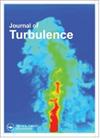Modeling rough walls from surface topography to double averaged Navier-Stokes computation
IF 1.5
4区 工程技术
Q3 MECHANICS
引用次数: 1
Abstract
The discrete element method was recently revisited using a double averaged Navier-Stokes formulation [Chedevergne F. A double-averaged navier-stokes turbulence model for wall flows over rough surfaces with heat transfer. J Turbul. 2021 Sep;22(11):713–734. doi:10.1080/14685248.2021.1973014] and a new closure relation for the drag coefficient [Chedevergne F, Forooghi P. On the importance of the drag coefficient modelling in the double averaged navier-stokes equations for prediction of the roughness effects. J Turbul. 2020 Aug;21(8):463–482. doi:10.1080/14685248.2020.1817465]. The developed model lies on the notion of representative elementary roughness whose characterisation needs to be generalised to provide a rigorous definition for randomly distributed rough configurations. From 3D scans of rough surfaces and simple image processing, a procedure was proposed to compute the blockage factor and the elementary diameter, the two main parameters of the representative elementary roughness. The procedure was successfully applied to two experimental configurations [Squire D, Morrill-Winter C, Hutchins N, et al. Comparison of turbulent boundary layers over smooth and rough surfaces up to high reynolds numbers. J Fluid Mech. 2016;795:210–240; Croner E, Léon O, Chedevergne F. Industrial use of equivalent sand grain height models for roughness modelling in turbomachinery. In: 55th 3AF International Conference on Applied Conference; Poitiers, France; Apr 2021. https://hal.archives-ouvertes.fr/hal-03228846]. Computed velocity profiles match experimental ones when the Reynolds number is varied, showing at the same time the relevance of the procedure and the validity of the double averaged Navier-Stokes model across the different rough regimes.从表面形貌到双平均Navier-Stokes计算的粗糙壁建模
最近,使用双平均Navier-Stokes公式[Chedevergne F.重新审视了离散元方法。粗糙表面上带传热的壁流的双平均Navier Stokes湍流模型。涡轮机杂志。2021年9月;22(11):713–734。doi:10.1080/14685248..2021.1973014]和阻力系数的一种新的闭合关系[Chedevergne F,Forooghi P.关于双平均navier-stokes方程中阻力系数建模对粗糙度影响预测的重要性。Turbul.2020 Aug;21(8):463–482。doi:10.1080/14685248..2020.1817465]。所开发的模型基于代表性基本粗糙度的概念,需要对其特征进行概括,以提供随机分布粗糙配置的严格定义。通过对粗糙表面的三维扫描和简单的图像处理,提出了一种计算阻塞因子和基本直径的程序,这是代表基本粗糙度的两个主要参数。该程序已成功应用于两种实验配置[Squire D,Morrill Winter C,Hutchins N等人。高雷诺数光滑和粗糙表面上湍流边界层的比较。流体力学杂志。2016;795:210–240;Croner E,Léon O,Chedevergne F。涡轮机械中粗糙度建模的等效沙粒高度模型的工业应用。在:第55届3AF国际应用会议;普瓦捷,法国;2021年4月。https://hal.archives-ouvertes.fr/hal-03228846]。当雷诺数变化时,计算的速度剖面与实验结果相匹配,同时显示了该程序的相关性和双平均Navier-Stokes模型在不同粗糙状态下的有效性。
本文章由计算机程序翻译,如有差异,请以英文原文为准。
求助全文
约1分钟内获得全文
求助全文
来源期刊

Journal of Turbulence
物理-力学
CiteScore
3.90
自引率
5.30%
发文量
23
审稿时长
6-12 weeks
期刊介绍:
Turbulence is a physical phenomenon occurring in most fluid flows, and is a major research topic at the cutting edge of science and technology. Journal of Turbulence ( JoT) is a digital forum for disseminating new theoretical, numerical and experimental knowledge aimed at understanding, predicting and controlling fluid turbulence.
JoT provides a common venue for communicating advances of fundamental and applied character across the many disciplines in which turbulence plays a vital role. Examples include turbulence arising in engineering fluid dynamics (aerodynamics and hydrodynamics, particulate and multi-phase flows, acoustics, hydraulics, combustion, aeroelasticity, transitional flows, turbo-machinery, heat transfer), geophysical fluid dynamics (environmental flows, oceanography, meteorology), in physics (magnetohydrodynamics and fusion, astrophysics, cryogenic and quantum fluids), and mathematics (turbulence from PDE’s, model systems). The multimedia capabilities offered by this electronic journal (including free colour images and video movies), provide a unique opportunity for disseminating turbulence research in visually impressive ways.
 求助内容:
求助内容: 应助结果提醒方式:
应助结果提醒方式:


